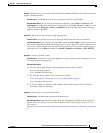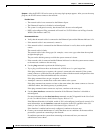
1-13
FAQ and Troubleshooting Guide for the CiscoWorks Wireless LAN Solution Engine
OL-8376-01
Chapter 1 FAQs and Troubleshooting
Faults FAQs and Troubleshooting
A.
Yes. For more detailed information on which policies can report traps (RF Port Status and RF Port
Admin Status) to the WLSE and how to set it up, see the online help or the User Guide for the
CiscoWorks Wireless LAN Solution Engine, 2.13.
Q.
What happens to faults when radio management features are disabled using the radiomanager
disable
CLI command?
A.
The following happens:
–
No new radio management related faults are generated.
Any radio management related faults that existed before the command was executed must be
cleared manually. After the faults are manually cleared, they are not regenerated even if the fault
condition still exists.
–
Non radio management faults are generated, then are cleared permanently when the fault
condition is rectified.
Any non radio management faults that existed before the command was executed can be cleared
manually. However, if the fault conditions still exist, the faults are regenerated.
Q.
The Fault Summary table is displaying the SSID in hexagonal format (for example,
"\x00\x00\x00\x00\x00\x00\x00\x00\x00"). What causes this?
A.
If the SSID contains unprintable characters, the WLSE displays it in hex notation. In this example,
the SSID is set to 9 hex zeros.
The WLSE displays unprintable characters as \xNN, where NN is the hex value of each character,
followed by the length of the SSID in bytes. For example, “\x00” [1] means that the SSID contains
the hex value \x00 and is 1 byte long. In addition, any double quote marks or backslashes that are
part of the SSID octets are displayed using a preceding backslash (for example, \" or \\).
Faults Troubleshooting
This section provides the following troubleshooting information:
• Symptom After adding an AAA server to a WLSE, the fault ‘AAA server is Not available’ is
generated for that AAA server.
• Symptom A polling interval for a fault is increased from one minute to a higher value, yet the fault
reappears after one minute, not in new time set for the polling.
• Symptom The Display Fault view is blank.
• Symptom Email fails to arrive at its destination.
• Symptom No VLAN fault information is displayed for IOS access points.
• Symptom No email notifications are being received for low priority faults.
• Symptom SNMP Unreachable faults are displayed more frequently than the set polling interval.


















